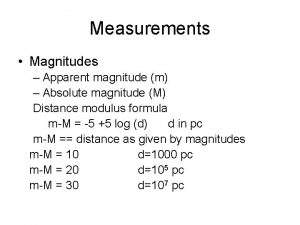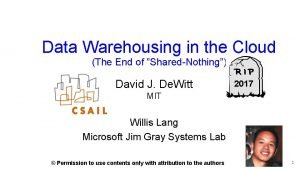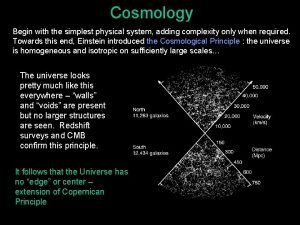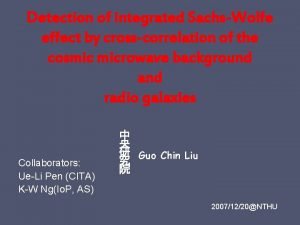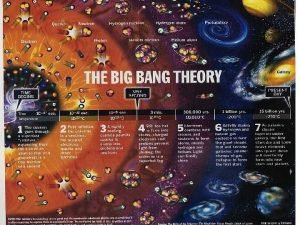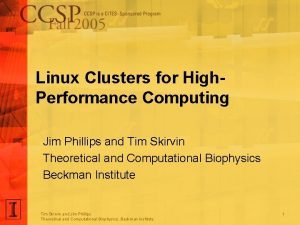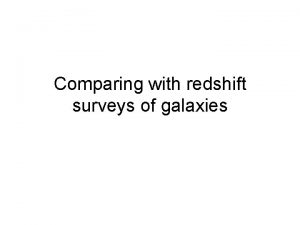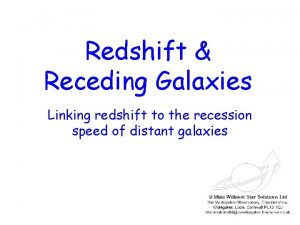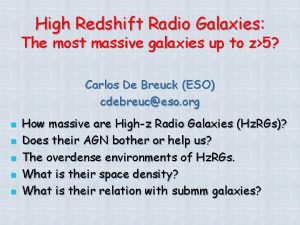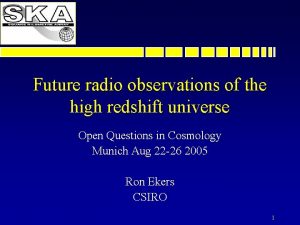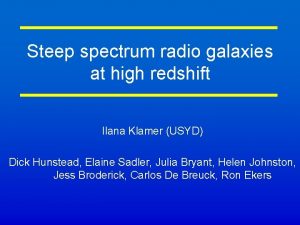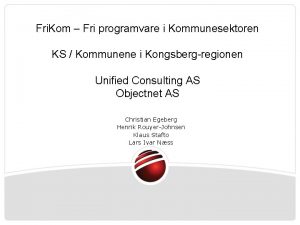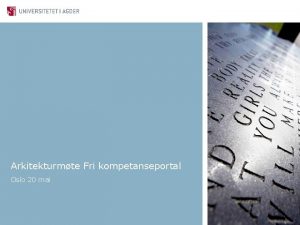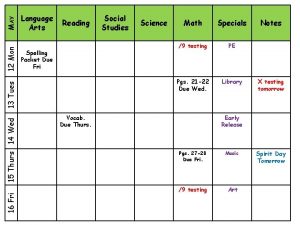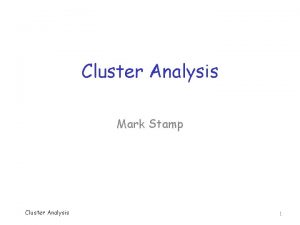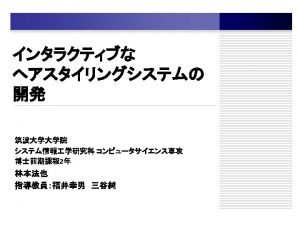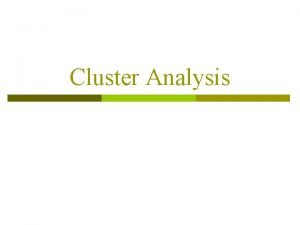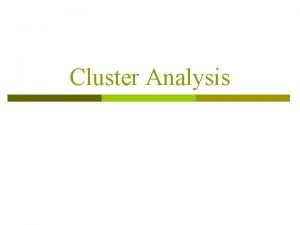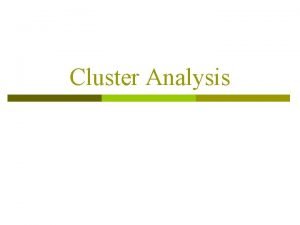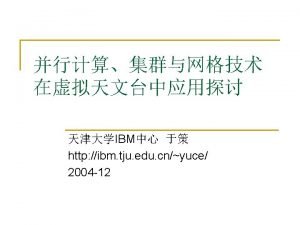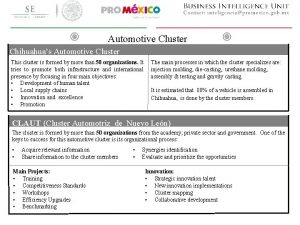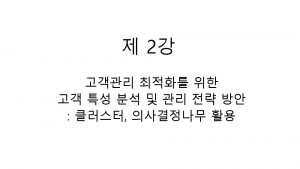The cluster environment of high redshift FRI radio















![Papovich (2008) method Red galaxies are selected ([3. 6]-[4. 5])AB> -0. 1 mag (SPITZER-COSMOS) Papovich (2008) method Red galaxies are selected ([3. 6]-[4. 5])AB> -0. 1 mag (SPITZER-COSMOS)](https://slidetodoc.com/presentation_image_h/fc1812f8bb371df9cb12972d2a32031c/image-16.jpg)









- Slides: 25

The cluster environment of high redshift FRI radio galaxies Gianluca Castignani (SISSA) Collaborators: Marco Chiaberge (STSc. I, INAF-IRA Bologna, JHU), Annalisa Celotti (SISSA), Colin Norman (JHU, STSc. I), Ranieri Baldi (SISSA)

Radio morphologies, Fanaroff & Riley (1974) FRIs FRIIs Zirbel (1996) FRI: Jet decelerates to v << c at ~1 kpc FRII: Relativistic jet on scales ~100 kpc up to ~1 Mpc FRI / FRII divide: L 178 MHz<2 x 1026 W Hz-1

Locally: FRIs “starved quasar”: quasar” faint optical nuclear emission (Chiaberge et al. 1999, Leiptzki et al. 2009, Baldi et al. 2010) Host galaxy: mainly giant elliptical (c. D) with the most massive BHs (Donzelli et al. 2007, Zirbel & Baum 1997) ~70% of them in rich clusters, at variance with FRIIs (Hill & Lilly 1991; Zirbel 1997; Wing & Blanton 2011) At high redshift: Two FRIs at z~1 (Snellen & Best 2001) ~30 FRI candidates at z~1 -2 (Chiaberge+09)

FRIs at z~1 -2. Clusters Beacons for HIGH REDSHIFT CLUSTERS Link between z>~2 protoclusters and clusters Formation and evolution of the red sequence Why? AGN Cosmological evolution unknown Hints for strong evolution up to z~0. 7 (Sadler et al. , 2007) Formation and evolution of the most massive galaxies and Bhs Feedback: BH accretion environment

The sample FRIs candidates at z~1 -2, Chiaberge et al. , 2009 (C 09) COSMOS (2 sq degrees) Mainly based on radio (FIRST) and optical selection, NOT on redshifts Redshifts Accurate redshifts (Baldi et al. 2013) are required to redefined the sample in radio power Few spectroscopic-z: z. COSMOS bright (Lilly et al. 2007) Magellan (Trump et al. 2007) Photo-z: SED modeling stellar population(s) and dust component(s)

Clusters around LLRGs? Cluster candidates around Low Luminous Radio Galaxies? (FRIs) The C 09 sample redefined in radio power 21 LLRGs 11 High Luminous Radio Galaxies (HLRGs)

Two cluster candidates Figure: Field of COSMOS-FRI 01, cluster from visual inspection RGB images. Red: Spitzer 3. 6μm. Green: optical i-band. Blue: optical V-band Figure: Field of COSMOS-FRI 026, cluster?

Cluster search techniques SZ effect, only a few at z>1 (e. g. Planck coll. XXIX 2013; Hasselfield et al. 2013, Reichardt et al. 2013) X-ray (Rosati et al. , 2002): B~(1+z)-4 Photo-z and number counts (Eisenhardt et al. 2008; Knobel 2009, 2012; George et al. 2011) Color selection (e. g. Gladders & Yee 2005; Papovich et al, 2008). Red-sequence is just forming between z~1 -2 (Hilton et al. 2010; Fassbender et al. 2011; Santos et al. 2011) Search around radio galaxies (Miley & De Breuck 2008, Galametz et al. 2012, Wylezalek et al. 2013) only FRIIs adopted

Poisson Probabiliy Method (PPM) Castignani et al. , in prep Existing methods seem to be less efficient at z>~1. 5 (only 9 spectroscopically confirmed z>~1. 5 clusters, see Tozzi et al. 2013) Methods based on photo-z and number counts (Scoville+2013 and ref. therein) affected by: 1) low number counts 2) increasing photo-z uncertainties 3) photo-z catastrophic failure at z~1. 5 (redshift desert)

PPM, how does it work?

PPM, how does it work? > 2 sigma > 3 sigma > 4 sigma

PPM plots 3. 5σ detection (LLRG)

PPM plots 3. 9σ detection (LLRG)

PPM plots 2. 5σ detection (LLRG)

Papovich (2008) method 1. 6 μm bump in the SED of red galaxies (opacity of the H− ion in atmospheres of cool stars, John 1988) Galametz et al. (2012)
![Papovich 2008 method Red galaxies are selected 3 64 5AB 0 1 mag SPITZERCOSMOS Papovich (2008) method Red galaxies are selected ([3. 6]-[4. 5])AB> -0. 1 mag (SPITZER-COSMOS)](https://slidetodoc.com/presentation_image_h/fc1812f8bb371df9cb12972d2a32031c/image-16.jpg)
Papovich (2008) method Red galaxies are selected ([3. 6]-[4. 5])AB> -0. 1 mag (SPITZER-COSMOS) The overdensity is evaluated as a number excess of red galaxies with respect of the COSMOS mean number density Seven >2σ orverdensities are detected All of them are also found with the PPM The Papovich (2008) test does not find our z~1 clusters. . . and some of our z≈2 candidates (e. g. 05, 226, also suggested in Chiaberge et al. 2010). Are they blue clusters?

Simulated clusters Two z~1 X-ray rich groups (M 500 ≈ 6 e+13 Msun - Finoguenov et al. 2007) moved at higher z Cluster membership based on: 1) PPM projected and redshift information 2) sources with the lowest (K-I)AB are selected Statistical Photo-z redshift uncertainties included IAB<25 selection (according to Ilbert et al. 2009)

Simulated clusters The groups are detected up to z=1. 5

Simulated clusters The groups are detected up to z=1. 5

Simulated clusters The groups are detected up to z=1. 5

Simulated clusters Spherically symmetric simulated groups - Richness (Nc = 10, 50, 100, 200, 300) - Redshift (zc = 1. 0, 1. 5, 2. 0) - Comoving size (Rc = 1. 0, 1. 5, 2. 0 Mpc) Rich groups (Nc≥ 100) are always detected Groups with Rc = 1 Mpc and Nc = 10 are detected at zc≥ 1. 5 Groups detected up to an offset of ~100 arcsec from the position of the cluster

Overdensity detections Gaussian filter to remove noisy patterns from the plot Overdensities selected at ∆z=0. 28 (i. e. 2σ photo-z uncertainty at z~1. 25 for i+AB~24 galaxies) Peak finding algorithm to detect each overdensity in the field The overdensities found within the FRI redshifts uncertainties are associated with the radio galaxy. LLRGs: 14/21 HLRGs: 8/11 69% . . . in agreement with what found locally

Gravitational arc in the field of COSMOS-FRI 01!! Figure: HST ACS image of the field of COSMOS-FRI 01

Stacked weak lensing analysis. . in s. K es R r O og W pr Courtesy of Matthew George (University of California – Berkley) Clusters around LLRGs only NFW+stars (George et al. 2012) Signal compatible with rich groups: M 200~1013. 3 Msun

Conclusions FRIs plus PPM → z∼ 1 -2 cluster search around FRIs candidates ~70% cluster detection success high redshift FRIs are in dense environment, as found locally Future work. . . Weak lensing signal from the stacking of our (LLRGs) cluster candidates (in progress. . . ) CM plots, red sequence? ? PPM and wide field surveys, e. g. SDSS Stripe 82, LSST: ∼ 1000 or more FRIs expected PPM needs beacons and good photo-z
 Apparent vs absolute magnitude
Apparent vs absolute magnitude Dwu
Dwu Lookback time
Lookback time Redshift deadlock detected
Redshift deadlock detected Big bang solar system
Big bang solar system Aws codedeploy icon
Aws codedeploy icon Redshift create index
Redshift create index Awin radio
Awin radio High performance computing cluster linux
High performance computing cluster linux Financial environment of business
Financial environment of business Emergent high level wellness
Emergent high level wellness Hát kết hợp bộ gõ cơ thể
Hát kết hợp bộ gõ cơ thể Frameset trong html5
Frameset trong html5 Bổ thể
Bổ thể Tỉ lệ cơ thể trẻ em
Tỉ lệ cơ thể trẻ em Voi kéo gỗ như thế nào
Voi kéo gỗ như thế nào Tư thế worm breton là gì
Tư thế worm breton là gì Alleluia hat len nguoi oi
Alleluia hat len nguoi oi Các môn thể thao bắt đầu bằng tiếng chạy
Các môn thể thao bắt đầu bằng tiếng chạy Thế nào là hệ số cao nhất
Thế nào là hệ số cao nhất Các châu lục và đại dương trên thế giới
Các châu lục và đại dương trên thế giới Công của trọng lực
Công của trọng lực Trời xanh đây là của chúng ta thể thơ
Trời xanh đây là của chúng ta thể thơ Mật thư anh em như thể tay chân
Mật thư anh em như thể tay chân Phép trừ bù
Phép trừ bù Phản ứng thế ankan
Phản ứng thế ankan
